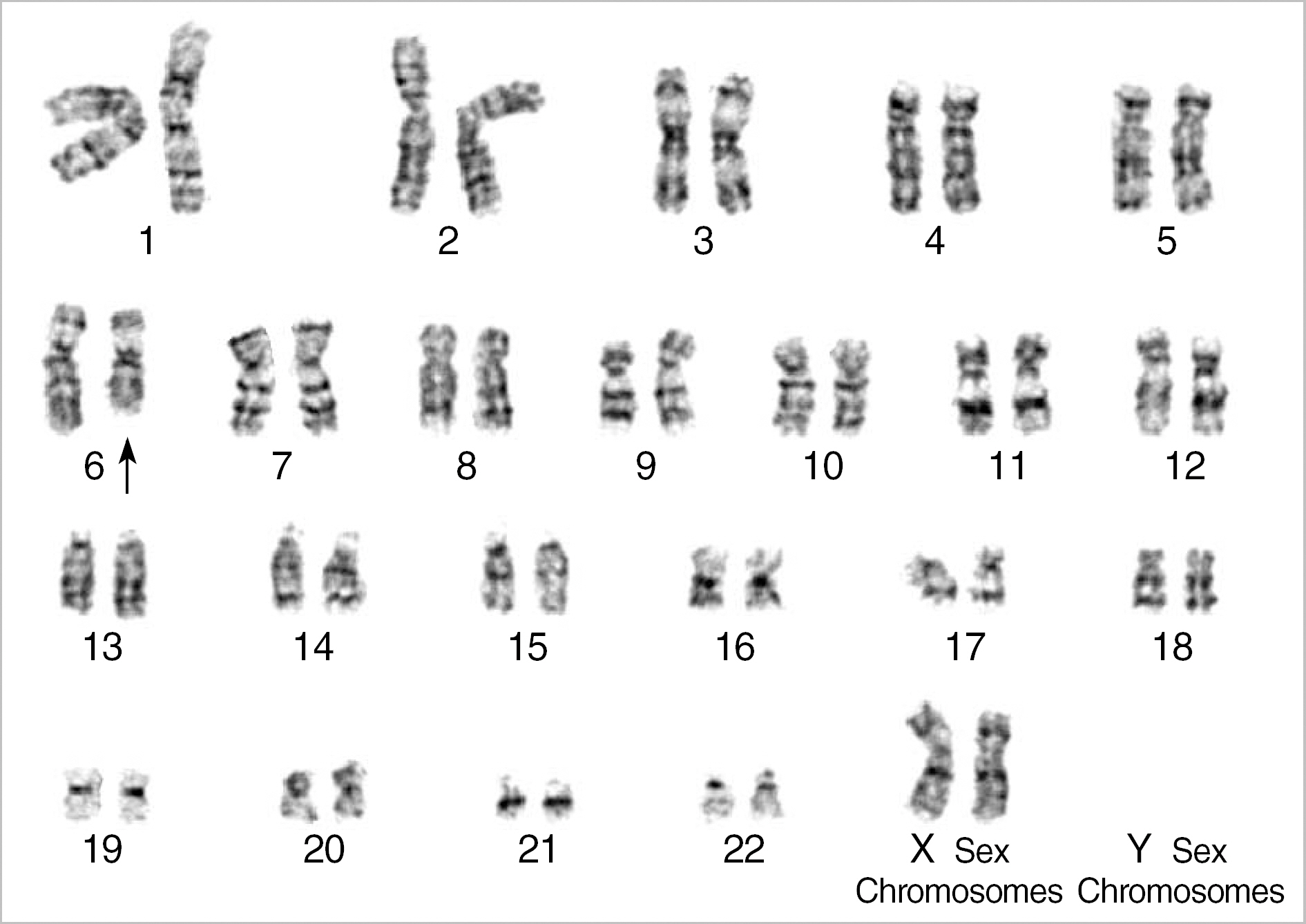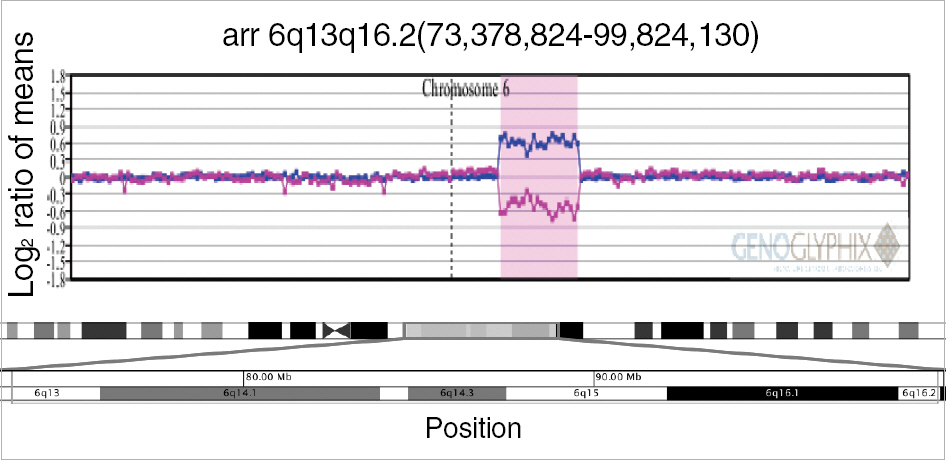Korean J Lab Med.
2010 Feb;30(1):84-88. 10.3343/kjlm.2010.30.1.84.
A de novo Proximal 6q Deletion Confirmed by Array Comparative Genomic Hybridization
- Affiliations
-
- 1Department of Laboratory Medicine, Dong-A University College of Medicine, Busan, Korea. jyhan@dau.ac.kr
- 2Department of Pediatrics, Dong-A University College of Medicine, Busan, Korea.
- 3Department of Obstetrics & Gynecology, Dong-A University College of Medicine, Busan, Korea.
- 4Signature Genomic Laboratories4, Spokane, WA, USA.
- KMID: 1096824
- DOI: http://doi.org/10.3343/kjlm.2010.30.1.84
Abstract
- Deletions of chromosome 6q, particularly in the proximal region, are relatively rare. Here, we report on a de novo interstitial deletion of (6)(q13q16.2) in a girl with facial dysmorphism, congenital hip dislocation, porencephaly, and brain atrophy. Array comparative genomic hybridization analysis showed arr 6q13q16.2(73,378,824-99,824,130), demonstrating higher resolution than the conventional cytogenetic findings, del(6)(q12q15). The clinical data were analyzed and compared with those of similar patients previously reported in the literature.
MeSH Terms
Figure
Reference
-
1.Chae KY., Nam YH. Deletion of the long arm of chromosome 6 associated with arachnoid cyst and brain atropy. J Korean Child Neurol Soc. 1999. 7:250–6.2.Hopkin RJ., Schorry E., Bofinger M., Milatovich A., Stern HJ., Jayne C, et al. New insights into the phenotypes of 6q deletions. Am J Med Genet. 1997. 70:377–86.
Article3.Mikkelsen M., Dyggve H. (6;15) Translocation with loss of chromosome material in the patient and various chromosome aberrations in family members. Hum Genet. 1973. 18:195–202.
Article4.Klein OD., Cotter PD., Moore MW., Zanko A., Gilats M., Epstein CJ, et al. Interstitial deletions of chromosome 6q: genotype-phenotype correlation utilizing array CGH. Clin Genet. 2007. 71:260–6.
Article5.Myers SM., Challman TD. Proximal 6q interstitial deletion without severe mental retardation. Genet Couns. 2005. 16:269–76.6.McNeal RM., Skoglund RR., Francke U. Congenital anomalies including the VATER association in a patient with del(6)q deletion. J Pediatr. 1977. 91:957–60.7.Young RS., Fidone GS., Reider-Garcia PA., Hansen KL., McCombs JL., Moore CM. Deletions of the long arm of chromosome 6: two new cases and review of the literature. Am J Med Genet. 1985. 20:21–9.
Article8.Yamamoto Y., Okamoto N., Shiraishi H., Yanagisawa M., Kamoshita S. Deletion of proximal 6q: a clinical report and review of the literature. Am J Med Genet. 1986. 25:467–71.
Article9.Slater HR., Robb A., Forsyth LA., Hamilton DA., Clark MC., Galloway CA. Interstitial deletion (6) (q11——q15) in an infant with congenital abnormalities. J Med Genet. 1988. 25:210–1.
Article10.Lonardo F., Colantuoni M., Festa B., Gentile G., Guerritore G., Perone L, et al. A malformed girl with a de novo proximal 6q deletion. Ann Genet. 1988. 31:57–9.11.Turleau C., Demay G., Cabanis MO., Lenoir G., de Grouchy J. 6q1 monosomy: a distinctive syndrome. Clin Genet. 1988. 34:38–42.
Article12.Valtat C., Galliano D., Mettey R., Toutain A., Moraine C. Monosomy 6q: report on four new cases. Clin Genet. 1992. 41:159–66.
Article13.Gershoni-Baruch R., Mandel H., Bar EI H., Bar-Nizan N., Borochowitz Z., Dar H. Interstitial deletion (6)q13q15. Am J Med Genet. 1996. 62:345–7.
Article14.Romie SS., Hartsfield JK Jr., Sutcliffe MJ., Dumont DP., Kousseff BG. Monosomy 6q1: syndrome delineation. Am J Med Genet. 1996. 62:105–8.
Article15.Kumar R., Riordan D., Dawson AJ., Chudley AE. Proximal interstitial 6q deletion: a recognizable syndrome. Am J Med Genet. 1997. 71:353–6.
Article16.Warman ML., Tiller GE., Polumbo PA., Seldin MF., Rochelle JM., Knoll JH, et al. Physical and linkage mapping of the human and murine genes for the alpha 1 chain of type IX collagen (COL9A1). Genomics. 1993. 17:694–8.17.Zherebtsov MM., Klein RT., Aviv H., Toruner GA., Hanna NN., Brooks SS. Further delineation of interstitial chromosome 6 deletion syndrome and review of the literature. Clin Dysmorphol. 2007. 16:135–40.
Article18.Gershoni-Baruch R., Mandel H., Bar El H., Bar-Nizan N., Borochowitz Z., Dar H. Interstitial deletion (6)q13q15. Am J Med Genet. 1996. 62:345–7.
Article19.Duran-Gonzalez J., Gutierrez-Angulo M., Garcia-Cruz D., de la Luz Ayala M., Padilla M., Davalos IP. A de novo interstitial 6q deletion in a boy with a split hand malformation. J Appl Genet. 2007. 48:405–7.20.Yu M., Obringer AC., Fowler MH., Hummel M., Wenger SL. Prenatal detection of deletion 6q13q15 in a complex karyotype. Prenat Diagn. 2005. 25:1084–7.
Article21.Schuster M., Lohscheller J., Kummer P., Eysholdt U., Rosanowski F. Severe sensory hearing loss in del(6q)-syndrome. Int J Pediatr Otorhinolaryngol. 2003. 67:1263–6.
Article22.Le Caignec C., Swillen A., Van Asche E., Fryns JP., Vermeesch JR. Interstitial 6q deletion: clinical and array CGH characterisation of a new patient. Eur J Med Genet. 2005. 48:339–45.
Article23.Hansson K., Szuhai K., Knijnenburg J., van Haeringen A., de Pater J. Interstitial deletion of 6q without phenotypic effect. Am J Med Genet A. 2007. 143A:1354–7.
Article24.Poliakov A., Cotrina M., Wilkinson DG. Diverse roles of eph receptors and ephrins in the regulation of cell migration and tissue assembly. Dev Cell. 2004. 7:465–80.
Article25.Posthumus M., September AV., O'Cuinneagain D., van der Merwe W., Schwellnus MP., Collins M. The association between the COL12A1 gene and anterior cruciate ligament ruptures. Br J Sports Med. 2009.
Article
- Full Text Links
- Actions
-
Cited
- CITED
-
- Close
- Share
- Similar articles
-
- Characteristics of Interstitial Deletion in Chromosome 4q Confirmed by Array Comparative Genomic Hybridization: A Case Report and Literature Review
- 14q32.33 Deletion Identified by array-CGH in a 5-year old-girl with Seizure
- A Case of an Interstitial Deletion in Chromosome 1p Confirmed by Array Comparative Genome Hybridization
- Patient With Delayed Development Resulting From De Novo Duplication of 7q36.1-q36.3 and Deletion of 9p24.3
- Current Status and Future Clinical Applications of Array.based Comparative Genomic Hybridization




